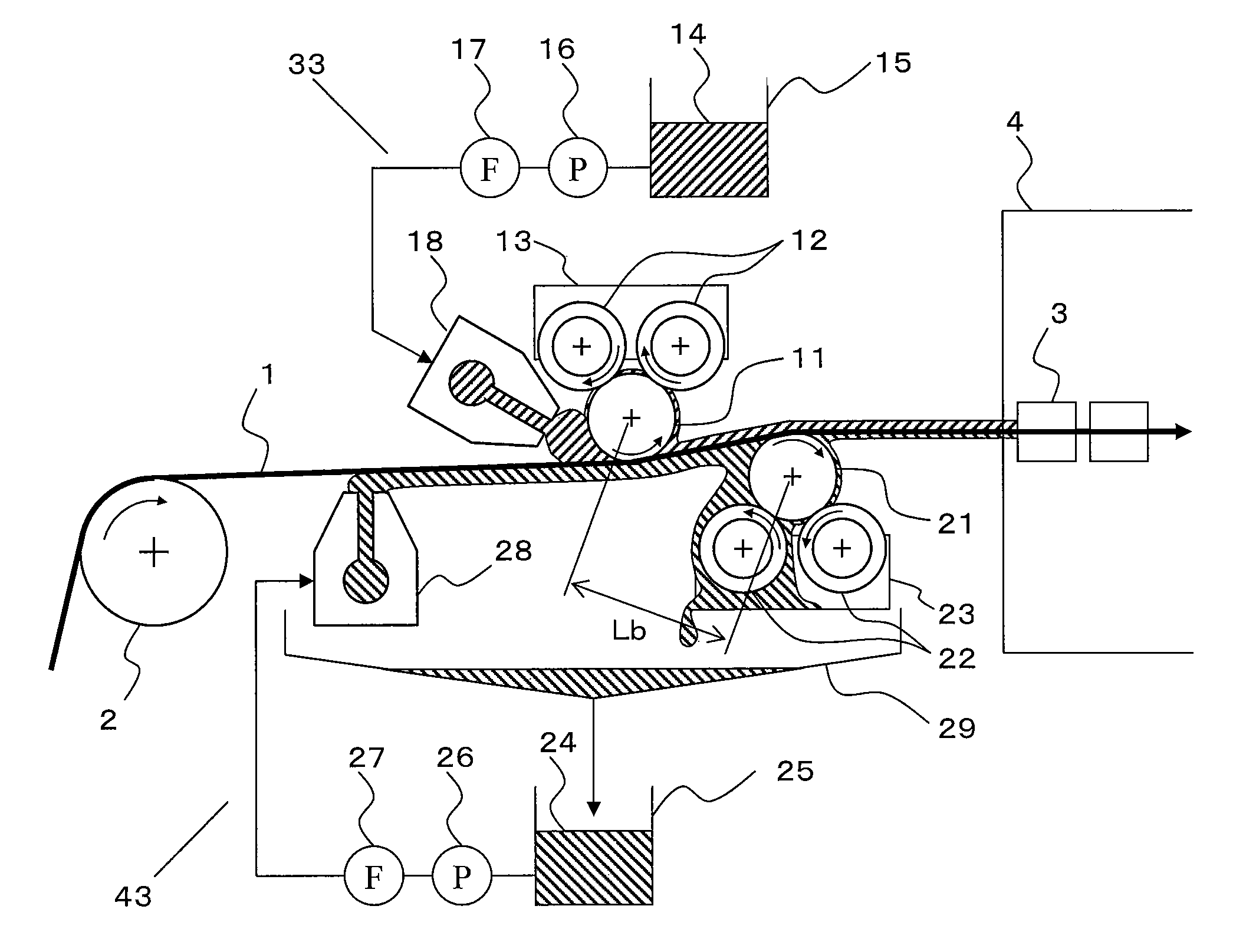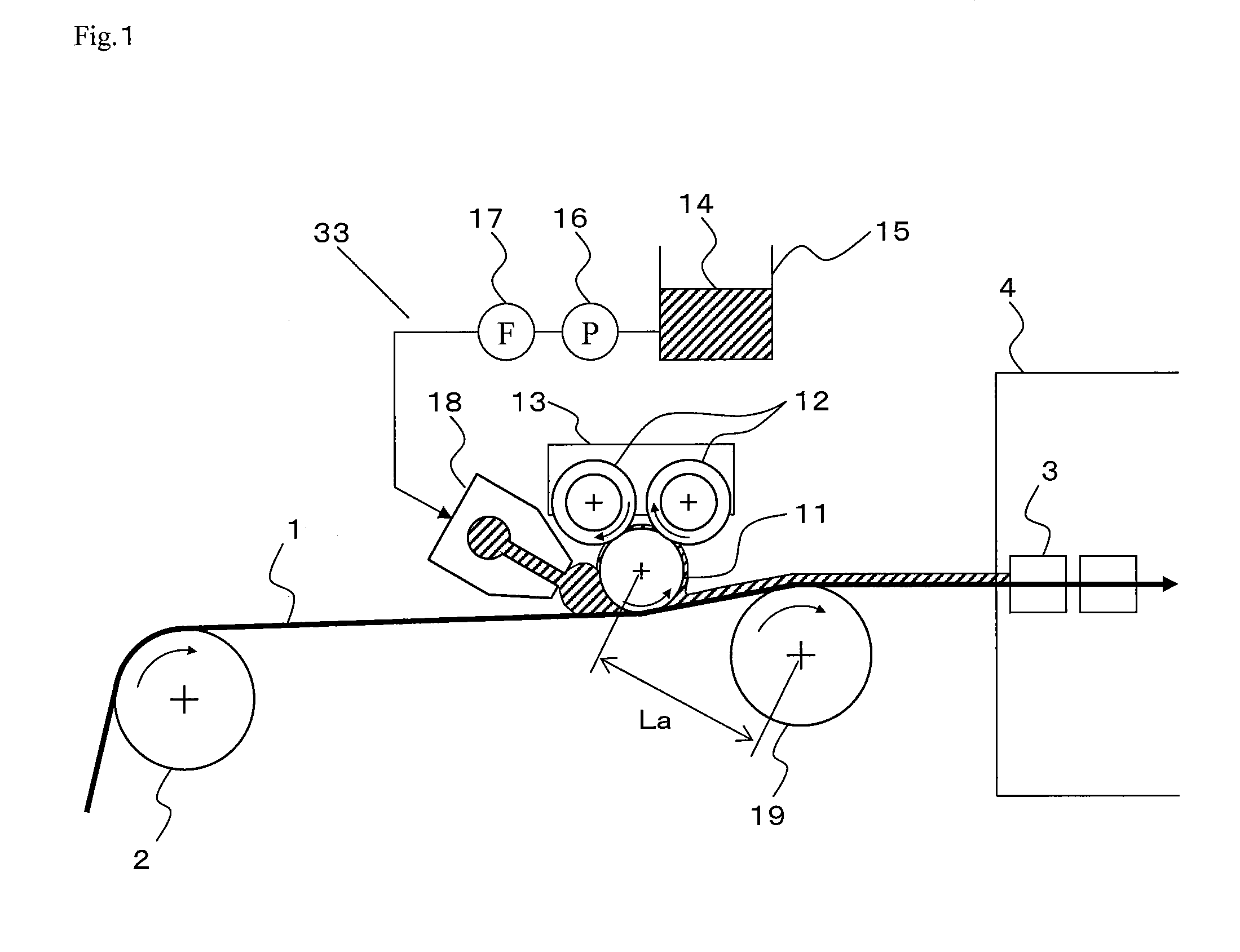Coating method and coating apparatus
a coating apparatus and coating technology, applied in the direction of coatings, chemistry apparatus and processes, ceramic layered products, etc., to achieve the effects of simple apparatus configuration, high viscosity, and easy operation and maintenan
- Summary
- Abstract
- Description
- Claims
- Application Information
AI Technical Summary
Benefits of technology
Problems solved by technology
Method used
Image
Examples
example 1
[0080]A chip of polyethylene terephthalate (hereinafter, abbreviated as PET) having a limiting viscosity (sometimes also referred to as intrinsic viscosity) of 0.62 dl / g (measured in o-chlorophenol at 25° C. according to standards of JIS K7367) was sufficiently vacuum-dried at 180° C., thereafter supplied to the extruder 91 and melted there at 285° C., then extruded into a sheet shape from the T-letter mouth ring 92, and taken up by the mirror-surface cast drum 93 having the surface temperature of 23° C. and cooled down to be solidified by means of the electrostatic application cast method so that an unstretched film was obtained. Then, the unstretched film was heated by a group of rolls heated to 80° C. in the longitudinal stretcher, stretched by 3.2 times as long in the length direction while heating by an infrared heater, and then, cooled down by a cooling roll adjusted to 50° C., so that a uniaxially stretched resin film 1 was obtained. The width W of the resin film 1 was 1,600 ...
example 2
[0086]A biaxially stretched film, in which the cured film of the coating liquid 14 was formed on one surface, was obtained as in Example 1 except that the distance La between the axial centers of the coating rod 11 and the guide roll 19 in Example 1 was set to 1,200 mm, in other words, set to be larger than ½ of the width W of the resin film 1. In this case, the liquid pool was not adequately formed immediately before the portions of the coating rod 11 and the resin film 1 contacting each other, and was discontinuous in the width direction. Further, a large number of coating streaks were detected on the coating surface.
[0087]When the discharge amount of the pump 16 was increased to 770 g / min, the liquid pool was adequately formed, and the coating streaks were no longer detected. The coating width immediately after the smoothening by the coating rod 11 was 1,400±20 mm, and the variation of the coating width stayed in an allowable range in view of the process stability. The thickness ...
example 3
[0088]The coating liquid 14 was applied to both of the upper surface and the lower surface of the resin film 1 by the coating apparatus shown in FIG. 12. The guide roll 19 in Example 1 was not used, and the lower surface of the resin film 1 was supported by the coating rod 21 instead. A wire rod where a wire made of the material SUS304 and having the diameter of 0.1 mm was wound around a round bar made of the material SUS304, diameter of D2=19 mm, and width of 1,900 mm (manufactured by Kano Shoji Co., Ltd.) so that a groove was formed was used as the second coating rod 21. The distance Lb between the axial centers of the coating rod H and the second rod 21 was set to 100 mm. In the roller 22, thermoplastic polyurethane elastomer having the thickness of 2.5 mm and the degree of hardness of 90 A was bonded to a surface of an aluminum pipe member having the diameter of 17 mm and the width of 14 mm. In the support member 23, two rollers 22 were horizontally disposed with the distance be...
PUM
| Property | Measurement | Unit |
|---|---|---|
| viscosity | aaaaa | aaaaa |
| viscosity | aaaaa | aaaaa |
| thickness | aaaaa | aaaaa |
Abstract
Description
Claims
Application Information
 Login to view more
Login to view more - R&D Engineer
- R&D Manager
- IP Professional
- Industry Leading Data Capabilities
- Powerful AI technology
- Patent DNA Extraction
Browse by: Latest US Patents, China's latest patents, Technical Efficacy Thesaurus, Application Domain, Technology Topic.
© 2024 PatSnap. All rights reserved.Legal|Privacy policy|Modern Slavery Act Transparency Statement|Sitemap



